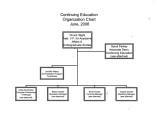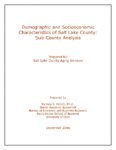TO
Filters: Collection: "ir_eua"
| Title | Date | Subject | Description | ||
|---|---|---|---|---|---|
| 1 |
 |
Required Documentation 2.3(ii): Summary listing of off-campus programs, directors, sites, and enrollments | The University of Utah 2006 Self-Study Required Documentation: Standards 1-4. Standard 2: Educational Program and Its Effectiveness. Part 3: Continuing Education and Special Learning Actitivities. Section 2: Summary listing of off-campus programs, directors, sites, and enrollments | ||
| 2 |
 |
Method and appratus for extracting tar sand | 1983-11-22 | tar sand extraction; extraction method; patent; tar sand; extraction apparatus | Method and apparatus for separating coarse sand particles from fine sand particles in a slurry of sand and a solution such as results from the solvent extraction of tar sand, such method comprising causing flow of such slurry in a generally horizontal direction and then causing upward flow at a rate... |
| 3 |
 |
Required Documentation 2.3(i): Organizational charts which show the relationship of continuing education | The University of Utah 2006 Self-Study Required Documentation: Standards 1-4. Standard 2: Educational Program and Its Effectiveness. Part 3: Continuing Education and Special Learning Actitivities. Section 1: Organizational charts which show the relationship of continuing education to various academ... | ||
| 4 |
 |
Resource evaluation of selected tar-sand deposits in southern Oklahoma | 1987-11-02 | resource evaluation; tar-sand deposits; southern Oklahoma; sulphur deposit; bitumen content | The cooperative program between the Oklahoma Geological Survey and the U.S. Department of Energy has permitted evaluation of specific tar-sand deposits in Carter and Murray counties, Oklahoma. The Sulphur deposit was evaluated by a combination of industry and DOE-OGS boreholes. Bitumen content of th... |
| 5 |
 |
Part 3 | |||
| 6 |
 |
Part 4 | |||
| 7 |
 |
Demographic and socioeconomic characteristics of Salt Lake County: sub-county analysis | 2006-12 | Salt Lake County; Projections; Estimates; Aging population; Baby boom; Utah; Salt Lake Aging Services; Kennecott Land | This paper is an examination of the shifting geographic distribution of the population within Salt Lake County over time as well as an analysis of the spatial distribution of its demographic and socioeconomic characteristics. It builds on the county-level analysis included in a separate section of t... |
| 8 |
 |
Part 4 | |||
| 9 |
 |
Required Documentation 8: Campus Map | The University of Utah 2006 Self-Study Required Documentation: Standards 6-8. Standard 8: Campus Map | ||
| 10 |
 |
Transportation system map portfolio | 1969-12 | ||
| 11 |
 |
Salt Lake County's distinctive demographics: implications for the aging population | 2006-12 | Salt Lake County; Projections; Estimates; Aging population; Baby boom; Utah; Salt Lake Aging Services; Kennecott Land | Salt Lake County is the economic, political, and cultural center of Utah. The county is currently home to nearly 40 percent of Utah residents and generates about half of all jobs in the state. It remains the most populous county, with a million of the state's 2.6 million residents,1 and its daytime ... |
| 12 |
 |
Basic Institutional Data for the University of Utah | 2006-08-30 | Accreditation; Higher Education, University of Utah | Northwest Commission on Colleges and Universities Basic Institutional Data Form for the University of Utah |
| 13 |
 |
Chemistry and resources of heavy oil and natural bitumen deposits | 1989 | chemistry of heavy oil; chemistry of natural bitumen deposits; heavy oil resources; natural bitumen deposits; heavy oil; unconventional oil deposits; natural bitumen | Supplies of conventional crude oil are diminishing; therefore, it is important to understand the reservoir characteristics of unconventional oil deposits. Reservoirs of unconventional deposits contain oils heavier than 20° gravity API and natural bitumens (tar sands and oil sands) are more viscous ... |
| 14 |
 |
Evaluation Committee, October 9-11, 2006 | 2006-09-26 | Accreditation; Higher Education, University of Utah | Northwest Commission of Colleges and Universities Evaluation Committee |
| 15 |
 |
Metallopetroporphyrines as process indicators: Separation of petroporpyrins in Green River oil shale pyrolysis products | 1994-11 | product oils; LLNL hot-recycled-solids; HRS retorting process; metallopetroporphyrins; process indicators; petroporpyrins; Green River oil shale pyrolysis | Product oils from the LLNL Hot-Recycled-Solids (HRS) retorting process were separated to isolate and concentrate the metallopetroporphyrins. A modified column chromatography procedure developed previously for heavy crude oils and tar sand bitumens was used. The fractions were then examined by UV-vis... |
| 16 |
 |
Process and apparatus for separating coarse sand particles and recovering bitumen from tar sands | 1978-10 | sharp separation from tar sands; tar sands; bitumen recovery; patent; solvent extraction | A system for effecting a sharp separation from tar sands of the large weight fraction of coarse materials present therein and for recovering bitumen, or tar, from the remaining product, wherein, as a first step, finely divided particles of a tar sand are added to a liquid hydrocarbon solvent in an a... |
| 17 |
 |
Technical aspects of oil shale production and processing | 2008-11-13 | oil; oil sand; oil shale; energy production; resource characterization pyrolysis; ex-situ process. | |
| 18 |
 |
Comparison of kinetic analysis of source rocks and kerogen concentrates | 1994-05-10 | Shales and kerogen concentrates from the Green River, Rundel, Ohio, Kimmeridge, and Phosphoria formations were examined by Pyromat II micropyrolysis and kinetic parameters were determined by the shift-in-Tm a x , discrete distribution, modified Friedman, and modified Coats-Redfern methods. Overall, ... | |
| 19 |
 |
Education | 1973 | ||
| 20 |
 |
Campus Map | |||
| 21 |
 |
Campus Map | |||
| 22 |
 |
Campus Map | |||
| 23 |
 |
Kinetic analysis of California oil shale by programmed temperature micropyrolysis | 1991-12-09 | oil shale; micropyrolysis | Three oil shales from California were examined by micropyrolysis for evolution behavior and pyrolysis kinetic parameters to understand hydrocarbon evolution. The samples consisted of one from the Los Angeles basin, and two from the Monterey formation. The two Monterey shales were distinguished by lo... |
| 24 |
 |
United States tar sands | 1982 | U.S. tar sands; tar sands; Interstate Oil Compact Commission | The term 'Tar Sands' is a catch-all misnomer that includes asphaltic and oil-impregnated sandstones, siltstones, and other elastics and even limestones and other carbonates - but not "oil shales" or man-made paving material. A press agent might entitle this paper "OIL, the Overlooked Billions of Bar... |
| 25 |
 |
Metallopetroporphyrins as process indicators: mass spectral identification of Ni (ETIO) and Ni (DPEP) homologous series in Green River shale oil | 1994-12-05 | mass spectral identification; Green River shale oil; shale oil | Mass spectrometry (MS) of the porphyrin fraction of a demetallated shale oil from the LLNL Hot-Recycled-Solids retorting process exhibited homologous series of C25 to C33 (C28 maximum) for etio and C26 to C36 (C30 maximum) for DPEP (isocyclic) porphyrins, respectively. The sum of intensities after b... |
